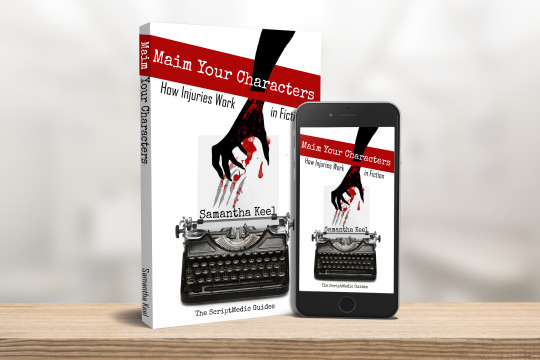#billy badbones

(This post is an excerpt from Maim Your Characters, which is out today!)
At its core, the Inciting Injury is the catalyst of the injury plot. It’s the moment when the leg snaps, the hammer comes down, or the bullet strikes. It’s the blossom of pain, the initial moment of agony.
There are two significant portions of the Inciting Injury:what happens, and why it happens.
Thewhat is going to determine the way the arc works. Is your character shot in the chest? Did they twist their ankle? Maybe they have a concussion, or a broken arm. You get the idea.
Of course, there’s also the why. The injury might be the effect of some other plot element that is causing your character harm. Did they poke their nose in the wrong badger hole? Are they simply a klutz, or is their injury a consequence of some choice they made earlier on, like going up against a mob boss or invading a foreign nation?
You don’t need to have a great why for a phenomenal injury story to work, as you’ll see in the form of an example: Steven King’s Misery, below.
Injuries tend to happen for one of two reasons. Either they’re completely random (you slip in the tub), or they’re a consequence of some other cause (you ventured into enemy territory and got shot). Which one you use is completely up to you, of course, but I would argue that the best Inciting Injuries are the byproduct of other elements in the plot.
We’re going to go over the exact process of building your own injury plot later on in the book (with an example and the choices we might face along the way), but as we go forward I’m going to give a few examples of the way famous writers have approached each of the elements we need to look at.
We’re also going to take a look at the arc of a fictional character I’ve made up: Billy Badbones, Demon Hunter. Where the other examples are going to get summaries, Billy’s story will be told in shortened versions of the actual scenes.
So let’s look at some examples of Inciting Injuries in fiction.
Example:Misery
Misery is a phenomenal piece of writing from Stephen King. (It was later adapted into a film, starring James Caan and Kathy Bates.) It’s a horror tale: a writer, Paul Sheldon, suffers a terrible car accident and is trapped in the house of his Number One Fan, the disturbed and disturbing Annie Wilkes. Wilkes is a nurse by trade – but an Angel of Death, a nurse who kills her patients. To survive, Paul must write Annie a novel all her own, resurrecting her favorite Sheldon character, Misery.
For Paul Sheldon, the what of his Inciting Injury is a car crash, which gives him a head injury, two broken legs, and a broken pelvis.
Thewhy is a simple accident: Sheldon, who has just finished his latest and greatest novel, goes driving in the snow. The storm picks up, and he crashes his car into a ditch. (Sheldon has just finished his latest and greatest novel). There’s a point to be made about hubris here, but King makes it subtly: it is Paul’s pride in his work that causes him to start driving in a Colorado snowstorm.
One thing that’s unique about Sheldon’s plot is the way in which it’s told. When we first see Sheldon, he’s waking up in a haze of pain and painkillers, at the beginning of his Rocky Road to Recovery. King chose to begin the tale in media res, in the middle of things – which meant starting at the heart of the story: the beginning of Sheldon’s relationship with Wilkes. We get the earlier phases as glimpses later on.
Example:Men of Honor
Men of Honor is a 2000 film that follows the career of real-life Navy diver Carl Brashear. Brashear, the first black diver in the Navy, faces struggle after struggle because of his race. He suffers unending injustices at the hands of the racist institution.
Nearly two-thirds of the way through the film, Brashear is on the deck of a ship when he sees significant tension being put on a line. Two other sailors are standing over it, and Brashear shoves them out of the way just as the line snaps – and brings a hunk of metal hurtling toward him at high speed.
Thewhat of his Inciting Injury is that the piece of metal breaks his leg, causing Brashear to immediately fall to the deck screaming in agony.
Thewhy is that Brashear is, in this portrayal of him, a hero. He saves two other men from a fate that could have been similar, or could have been worse. The why of his injury shows us who Brashear is: he throws himself into danger. (This scene immediately follows one in which he is on a dive and almost gets run over by a Russian nuclear submarine.)
Example:The Empire Strikes Back
The story of Luke Skywalker’s hand amputation is an interesting one. It’s not going to be presented here as a positive example. If anything, it’s closer to what not to do. We’ll see why that is later on, especially when we talk about magical healing, but for now, let’s just tell the story.
Luke Skywalker is a Jedi Knight taking on the evil Empire. He’s having a lightsaber showdown with one of the biggest bads in the ‘verse: Darth Vader himself, the Emperor’s right-hand man.
They’re dueling, fighting. It looks like Luke is going to have the upper hand… and then Vader gives Luke his Inciting Injury. He cuts off Luke’s hand with a lightsaber. Luke’s hand – and his own lightsaber – go sailing over the railing of the catwalk where they’re dueling.
Thewhat is an amputation of the right hand, conveniently cauterized by the blade.
(Isn’t sci-fi neat?)
Thewhy is that Luke is fighting for the freedom of all mankind – and facing an enemy far more powerful than he is.
Now what about our own example, Billy Badbones?
Homebrew Example: Billy Badbones
Billy Badbones is, well, a badass. He digs motorcycles, especially his late father’s Indian, and he guns down demonic drug lords. He rides across the nation, delivering grievous bodily harm and destroying heroin reserves everywhere he goes. He’s the Jack Reacher of demon drug busts.
He’s chasing the Demon Lord Shigure all along I-40, from Arizona to the East Coast. It’s been four days of hard rides and little sleep, and Billy’s exhausted. But he’s close on the demon’s heels, so he keeps going.
And, doing 60 down I-95, Billy Badbones falls asleep on the bike.
He does his best to keep his face off the pavement, but the fall lands his body weight on his arm. He can feel the bone crunch, feel the white-hot searing pain as his arm snaps under the weight.
He scrapes across the blacktop, ripping through his leather jacket. His favorite demon-killing gun goes skittering away, off the side of the road and into the underbrush. He and his bike go rocketing down the road, the metal sparking, his arm and leg screaming in agony.
He tries to slide, to take it on his back, but the bike has trapped his leg, and he’s getting crushed by the weight of it.
When he finally comes to a stop, the bike is mangled and so is he. He can only thank the gods that his bike isn’t on fire, that the driver behind him slammed on his brakes. The car stops ten feet shy of him.
Billy lays back on the pavement panting. He’s breathing heavily, but he’s alive. It could have been worse, he thinks.
It’s going to get worse.
InThe Hero’s Journey, Joseph Campbell writes about establishing the regular world before transitioning into the New World. Here we’ve talked about Billy’s regular world (health), and we see him come crashing into the New World (his upcoming disability). He’s begun his journey, even if it wasn’t his idea.
So the what of Billy’s Inciting Injury is that his arm and leg have been crushed, burned, and ripped up by road rash, and he’s been dragged by his motorcycle — he’s gonna be in some hurt!
Thewhyof his injury is his own exhaustion. Billy’s so driven to accomplish his goal – killing the Demon Lord Shigure – that he takes a spill off his bike on the highway at speed. It’s up to the reader to determine if that’s madness (working way too hard), or a marker of dedication (he must chase the demons!), or both.
Next up, we’re going to talk about the second half of the Beginning: the Immediate Treatment!

This post is an excerpt from Maim Your Characters, out TODAY from Even Keel Press. If you’d like to read a 100-page sample of the book, [click here]. If you’d like to order a print copy, it’s available [via Amazon.com], and digital copies are available from [a slew of retailers].
